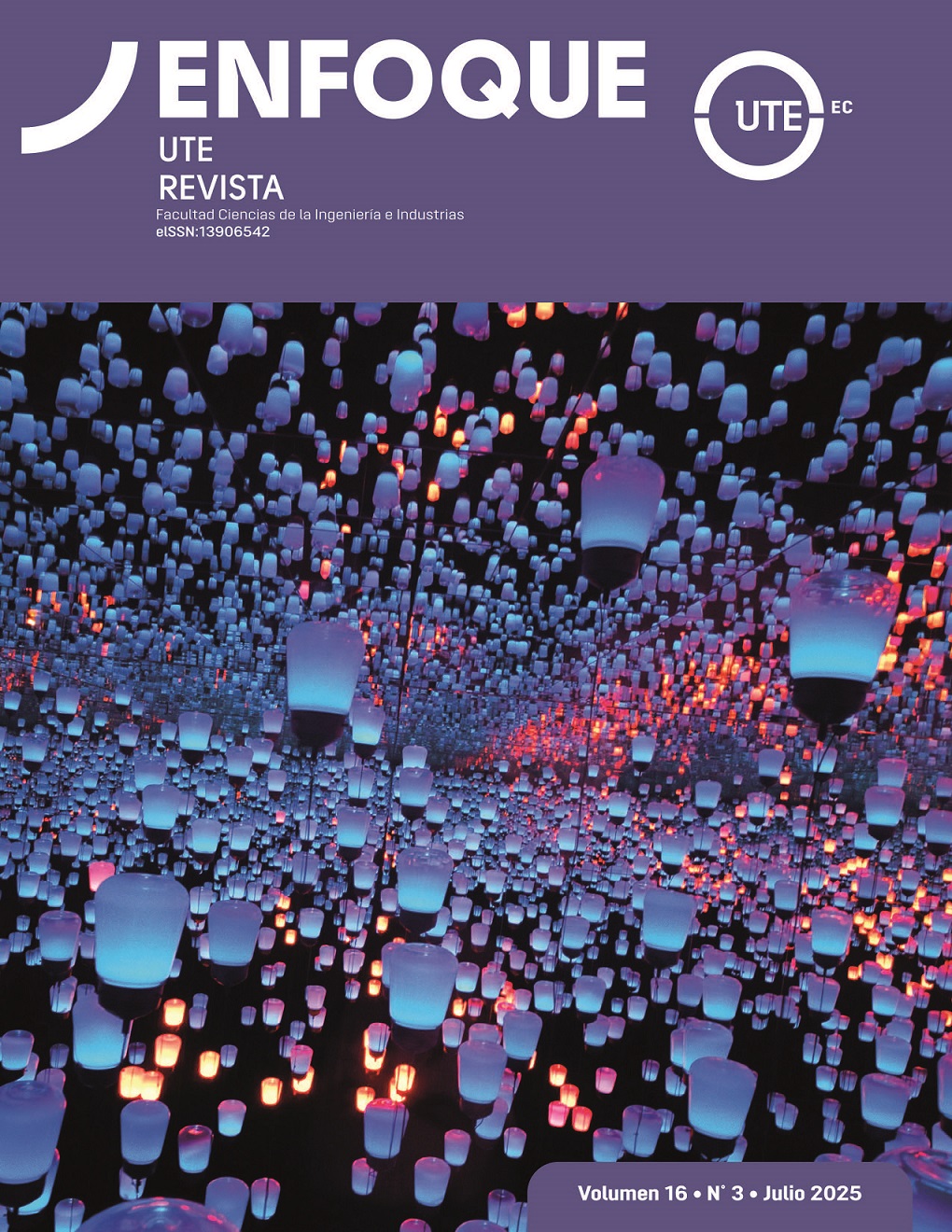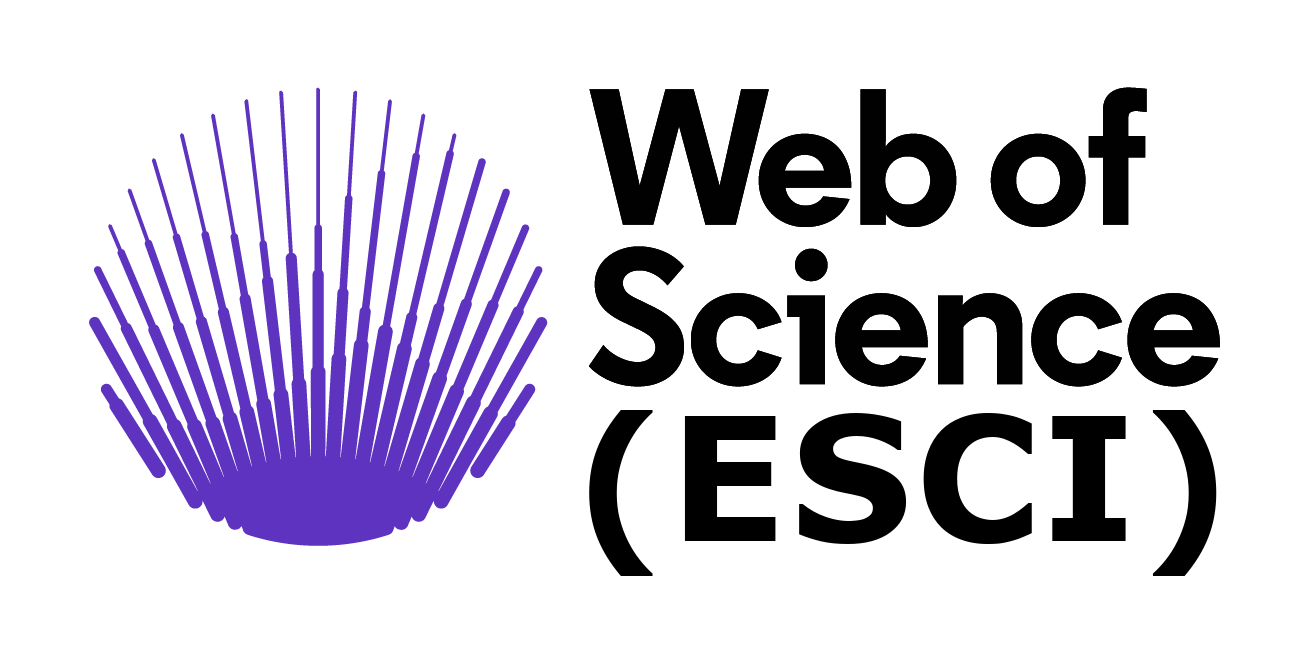Experimental Analysis of the Relationship between Flow Velocities and Sediment Transport in a Laboratory Channel Featuring a Lateral Bifurcation and Sand Bed
DOI:
https://doi.org/10.29019/enfoqueute.1150Keywords:
bifurcation, Acoustic Doppler Velocimeter (ADV), sediment transport, open-channel flowAbstract
This experimental study investigates the relationship between flow velocities and sediment transport in a laboratory flume featuring a 90 ° lateral bifurcation with a mobile sediment bed composed of medium sand (D₅₀ = 1.06 mm). The experiment was conducted at the Center for Research and Studies in Water Resources Engineering of the National Polytechnic School (CIERHI-EPN) using a scaled, fixed-geometry open-channel model under subcritical flow conditions with a constant discharge of 40 l/s. The objective is to establish empirical, experimentally validated correlations between flow structures and sediment dynamics in bifurcated channels. Instantaneous flow velocities were recorded at over 180 points using an Acoustic Doppler Velocimeter (ADV), and topographic measurements of the sediment bed were used to quantify scour and deposition. A total of 43.3 l of sand was scoured (with maximum depth of 15.01 cm), 8.0 l was redeposited (up to 8.49 cm thick), and 35.3 l was transported beyond the mobile bed. Results indicate that flow is predominantly one-dimensional in the upstream channel, while the bifurcation induces complex three-dimensional velocity components (Vₓ, Vᵧ, V𝓏) associated with shear layers, vortex formation, and sediment redistribution. Compared to previous studies that focused on fixed beds or numerical simulations, this research provides high-resolution, experimental evidence of the link between secondary flow structures and sediment transport patterns under mobile-bed conditions. The findings contribute to improved predictive capabilities for morphodynamic behavior in natural bifurcations and support the development of more efficient sediment control and hydraulic design strategies.
Downloads
References
[1] C. De Hidráulica, D. María, J. E. Ayala, M. I. José and A. González Verdugo, “Estudio de bifurcaciones en ríos. Informe Final,” Jiutepec, Morelos, 2015.
[2] R. N. Szupiany et al., “Flow fields, bed shear stresses, and suspended bed sediment dynamics in bifurcations of a large river,” Water Resour Res, vol. 48, no. 11, 2012. https://doi.org/10.1029/2011WR011677
[3] R. E. Thomas et al., “An experimental study of discharge partitioning and flow structure at symmetrical bifurcations,” Earth Surf Process Landf, vol. 36, no. 15, pp. 2069-2082, Dec. 2011. https://doi.org/10.1002/esp.2231
[4] I. Ibrahim, S. Legori Ibrahim and S. Khan, “Flow structures in dividing open channels: A review,” in IOP Conference Series: Earth and Environmental Science, Institute of Physics Publishing, Feb. 2020. https://doi.org/10.1088/1755-1315/437/1/012008
[5] A. Momplot, G. Lipeme Kouyi, E. Mignot, N. Rivière and J. L. Bertrand-Krajewski, “Typology of the flow structures in dividing open channel flows,” Journal of Hydraulic Research, vol. 55, no. 1, pp. 63-71, Jan. 2017. https://doi.org/10.1080/00221686.2016.1212409
[6] L. Szewczyk, J. L. Grimaud and I. Cojan, “Experimental evidence for bifurcation angles control on abandoned channel fill geometry,” Earth Surface Dynamics, vol. 8, no. 2, pp. 275-288, Apr. 2020. https://doi.org/10.5194/esurf-8-275-2020
[7] L. Durante, M. Bolla Pittaluga, G. Porcile, and N. Tambroni, “Downstream Control on the Stability of River Bifurcations,” J Geophys Res Earth Surf, vol. 129, no. 10, Oct. 2024. https://doi.org/10.1029/2023JF007548
[8] S. Miori, R. Repetto and M. Tubino, “A one-dimensional model of bifurcations in gravel bed channels with erodible banks,” Water Resour Res, vol. 42, no. 11, Nov. 2006. https://doi.org/10.1029/2006WR004863
[9] T. Y. Dong et al., “Predicting water and sediment partitioning in a delta 1 channel network under varying discharge conditions,” 2020. https://doi.org/10.1029/©2020.
[10] K. Kästner and A. J. F. Hoitink, “Flow and suspended sediment division at two highly asymmetric bifurcations in a river delta: implications for channel stability,” J Geophys Res Earth Surf, vol. 124, no. 10, pp. 2358-2380, Oct. 2019. https://doi.org/10.1029/2018JF004994
[11] M. Bolla Pittaluga, R. Repetto and M. Tubino, “Channel bifurcation in braided rivers: Equilibrium configurations and stability,” Water Resour Res, vol. 39, no. 3, 2003. https://doi.org/10.1029/2001WR001112
[12] S. Kostic and G. Parker, “Formation des deltas de sable et de boue dans les lacs et les réservoirs. 1ière Partie. Théorie et modélisation numérique,” Journal of Hydraulic Research, vol. 41, no. 2, pp. 127-140, 2003, https://doi.org/10.1080/00221680309499956
[13] B. Federici and C. Paola, “Dynamics of channel bifurcations in noncohesive sediments,” Water Resour Res, vol. 39, no. 6, 2003. https://doi.org/10.1029/2002WR001434
[14] M. E. Guevara Álvarez, Socavación en puentes: evaluación, instrumentación y cálculo. Popayán, Colombia: Editorial Universidad del Cauca, 2021.
[15] E. M. Laursen and A. Toch, “Scour around bridge piers and abutments, HR-30 and Iowa Highway Research” in cooperation with THl IOWA State Highway Commission and The Bureau of Public Roads, 1956.
[16] M. Naghavi, M. Mohammadi, G. Mahtabi and J. Abraham, “Experimental assessment of velocity and bed shear stress in the main channel of a meandering compound channel with one-sided blocks in floodplain,” J Hydrol (Amst), vol. 617, p. 129073, Feb. 2023. https://doi.org/10.1016/j.jhydrol.2023.129073
[17] L. Malik and M. A. Matin, “Experimental study on flow and sediment distribution at off-take channel,” International Journal of Environmental Science and Development, vol. 12, no. 2, pp. 35-41, 2021. https://doi.org/10.18178/ijesd.2021.12.2.1315
[18] A. H. Casas and A. Bateman Pinzón, “Experimental and theoretical analysis of flow and sediment transport in 90-degree fluvial diversions,” 2013. Universitat Politècnica de Catalunya.
[19] B. Standard and B. ISO, “Hydrometry—Measurement of liquid flow in open channels using current-meters or floats,” 2007, ISO.
[20] SonTek – a Xylem brand. (2019). FlowTracker2 User’s Manual (Version 1.6). Xylem Inc. https://www.geotechenv.com/Manuals/SonTek_Manuals/sontek_flowtracker2_manual.pdf
[21] S. J. Mclelland and A. P. Nicholas, “A new method for evaluating errors in high-frequency ADV measurements,” 2000.
[22] T. Kostić, Y. Ren and S. Theobald, “3D-CFD analysis of bedload transport in channel bifurcations,” Journal of Hydroinformatics, vol. 26, no. 2, pp. 480-493, Feb. 2024. https://doi.org/1010.2166/hydro.2024.175
[23] M. H. García, Sedimentation Engineering. Reston, VA: American Society of Civil Engineers, 2008. https://doi.org/10 10.1061/9780784408148
[24] P. R. Wilcock and S. T. Kenworthy, “A two‐fraction model for the transport of sand/gravel mixtures,” Water Resour Res, vol. 38, no. 10, Oct. 2002. https://doi.org/10 10.1029/2001WR000684
[25] L. C. van Rijn, “Sediment Transport, Part II: Suspended Load Transport,” Journal of Hydraulic Engineering, vol. 110, no. 11, pp. 1613-1641, Nov. 1984. https://doi.org/1010.1061/(ASCE)0733-9429(1984)110:11(1613)
[26] P. R. Wilcock, “Critical shear stress of natural sediments,” Journal of Hydraulic Engineering, vol. 119, no. 4, pp. 491-505, Apr. 1993. https://doi.org/1010.1061/(ASCE)0733-9429(1993)119:4(491)
[27] W. A. Marra, D. R. Parsons, M. G. Kleinhans, G. M. Keevil and R. E. Thomas, “Near-bed and surface flow division patterns in experimental river bifurcations,” Water Resour Res, vol. 50, no. 2, pp. 1506-1530, 2014. https://doi.org/1010.1002/2013WR014215
[28] K. Hamad Mohamed, “Submerged vanes turbulence: experimental analysis,” 2015.
[29] Y. Wang and A. Jacob Odgaard, “Flow control with vorticity,” Journal of Hydraulic Research, vol. 31, no. 4, pp. 549-562, 1993.
[30] A. Das, B. C. Barman and N. Nandi, “On some aspects of flow characteristics of the bifurcated channel – An experimental approach,” ISH Journal of Hydraulic Engineering, vol. 29, no. 2, pp. 147-153, Mar. 2023. https://doi.org/1010.1080/09715010.2022.2042862.
[31] A. Herrero, A. Bateman and V. Medina, “Water flow and sediment transport in a 90° channel diversion: An experimental study,” Journal of Hydraulic Research, vol. 53, no. 2, pp. 253-263, Mar. 2015. https://doi.org/10 10.1080/00221686.2014.989457
[32] I. Nezu and H. Nakagawa, Turbulence in Open-Channel Flows. Routledge, 2017. https://doi.org/1010.1201/9780203734902
[33] J. L. Best, “Flow dynamics at river channel confluences: implications for sediment transport and bed morphology,” in Recent Developments in Fluvial Sedimentology, SEPM (Society for Sedimentary Geology), 1987, pp. 27-35. https://doi.org/1010.2110/pec.87.39.0027
Published
Issue
Section
License
Copyright (c) 2025 The authors

This work is licensed under a Creative Commons Attribution 4.0 International License.
The authors retain all copyrights ©.
- The authors retain their trademark and patent rights, as well as rights to any process or procedure described in the article.
- The authors retain the right to share, copy, distribute, perform, and publicly communicate the article published in Enfoque UTE (for example, post it in an institutional repository or publish it in a book), provided that acknowledgment of its initial publication in Enfoque UTE is given.
- The authors retain the right to publish their work at a later date, to use the article or any part of it (for example, a compilation of their work, lecture notes, a thesis, or for a book), provided that they indicate the source of publication (authors of the work, journal, volume, issue, and date).
























